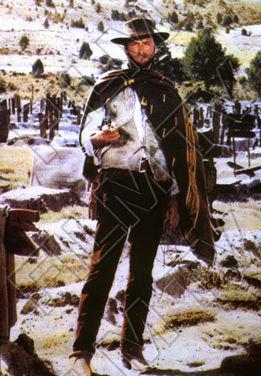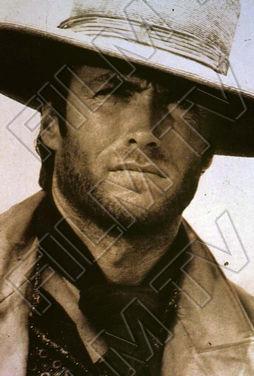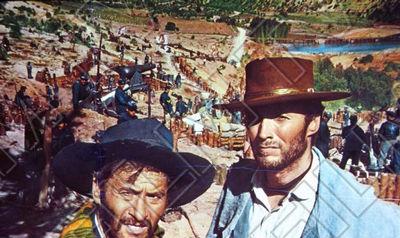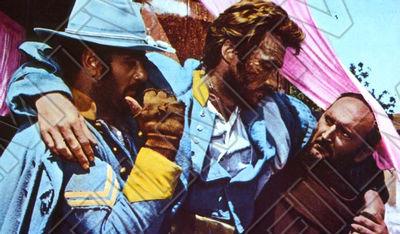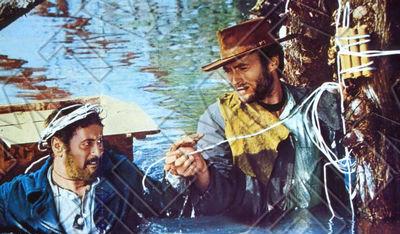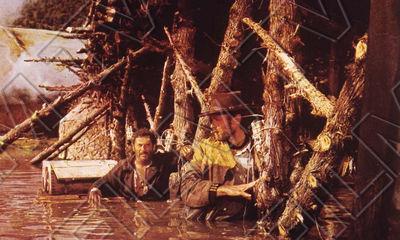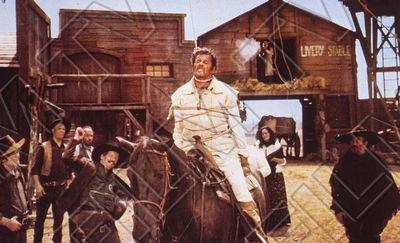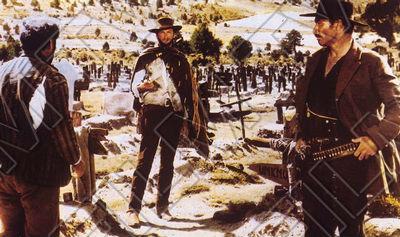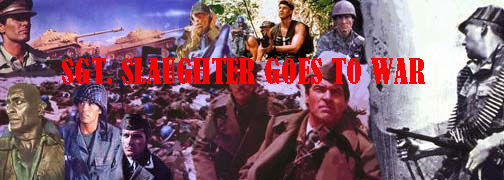
THE GOOD, THE BAD AND THE UGLY (1966)

DIRECTOR:
Sergio Leone
CAST:
Clint Eastwood, Eli Wallach, Lee Van Cleef, Mario Brega, Aldo Giuffre, Luigi Pistilli, Antonio Molino Rojo, Antonio Casale, Livio Lorenzon, Rada Rassimov, Enzo Petito, Antonio Casas, Angelo Novi, Al Mulock, Victor Israel, John Bartha, Benito Stefanelli, Lorenzo Robledo and Frank Brana.
REVIEW:
Sergio Leone’s third installment in his spaghetti western “Dollars” trilogy is a full-blown epic about greed and the wasteful, destructive nature of warfare.
In 1862 Texas, we meet Tuco Ramirez (Eli Wallach), a petty thief with a price on his head. His friend Blondie (Clint Eastwood) runs a scam in which he turns Tuco in for a bounty, and then as he about to be hanged shoots the rope and the two split the reward money. Meanwhile, Angel Eyes (Lee Van Cleef) is hired by Baker (Enzo Petito), a bedridden Confederate soldier to find out from Stevens (Antonio Casas) what name a certain Jackson (Antonio Casale) is currently hiding under. Angel Eyes not only finds out the name, but also learns that Baker, Jackson and Stevens have stolen a case of $200,000 in gold coins from the Confederate Army and hidden it. Angel Eyes sets off in search of Jackson, and it’s only a matter of time and coincidence until Tuco and Blondie become embroiled in this obsessive search, too.
The three lead performances are the heart and soul of this film; not a scene passes in which Eastwood, Wallach or Van Cleef graces the screen. Eastwood (“The Good”) is a quiet, restrained presence who only speaks when he has to. When he does, everyone around him shuts up and listens. Wallach’s Tuco (“The Ugly”) is the exact opposite. When he should shut up, he elects to yak, shout and yell excitedly at everyone around him. And he comes up with some of the best derogatory insults, too. In one scene, Tuco and Blondie are disguised as Confederates, and Tuco calls out to fellow “Confederate” soldiers, only to realize that they are Union cavalrymen covered with dust. Rounding out the trio is Van Cleef’s incredibly “bad” Angel Eyes character. Angel Eyes is the epitome of emotionless evil. Nothing motivates this man except pure, selfish greed. He’s willing to kill anyone who gets in his way. His first two scenes revolve around brutal murders; he beats innocent women and, later, has Tuco beaten in one of the harshest torture sequences ever shot.
Leone does give each of his leads a hint of humanity. For Blondie, it’s a brief, silent encounter with a dying Confederate soldier near the film’s conclusion. For Tuco, it’s an encounter with his long-lost brother Pablo (Luigi Pistilli), who’s become a priest; and for Angel Eyes, it’s a look of disgust when he stumbles across a forgotten Confederate outpost.
This film revolves around violent encounters. As Richard Schickel notes in his almost useless commentary on the new “Special Edition” DVD, Leone likes to draw out his action sequences almost too far. Nobody can make this combination of long silences concluded with quick, explosive action work the way Leone does. In the first 15 minutes of the film, only one dialogue exchange occurs, and six people have been murdered. The first scene consists of several mean-looking bounty hunters converging on Tuco, only to have him quickly kill all four of them and then escape through a glass window. The second is an exchange between Angel Eyes and Stevens. We know from the moment we’re introduced to Angel Eyes how this scene will end, but it takes quite a long time to get to the expected conclusion. Scenes like these occur throughout, building up to the final gunfight, which consists of about five minutes of itchy eyes and twitching trigger fingers, building up to a single climactic gunshot.
The theme of this movie is, undeniably, that war is a destructive waste of lives. I first saw “The Good, the Bad and the Ugly” at an early age and didn’t really understand Leone’s theme, but subsequent viewings over the years and a greater understanding of film as art have helped me to pick up on many of the underlying (and often blatantly stated) ideas which the central conflict revolves around. No significant military character is unaffected by the war. There’s the legless soldier whom Van Cleef pays for information; Stevens has a bum leg; Baker is dying in bed; the drunken Captain (Aldo Giuffre) is addicted to alcohol, and later, is wounded; Captain Harper (Antonio Molino Rojo) has a gangrenous leg; and so on. Nobody who fights in a war is unaffected by the consequences. Even innocent people: the young blond boy from whom Eastwood received his famous poncho; Stevens’ murdered son and there’s Maria, the victim of rape by Confederate soldiers.
Leone’s directorial style comes out full-force in this film. He felt the best way to show a character’s true emotion was to get in close – and he does get in very close. At least 25% of the film is composed of intense close-ups. Another 25% is shot with extreme wide angles, framing a central character against expansive backgrounds. The sets in this movie are spectacular; Stevens’ pueblo is a real standout. Most of the film occurs outdoors and was shot in Almeria, Spain by brilliant cinematographer Tonino delli Colli. These exteriors are simultaneously beautiful and haunting. There’s something new and out-of-the ordinary about them. Tuco and Blondie’s decent into a desert hell is especially memorable, and later on, the colossal battle between Union and Confederate brigades has got to be one of the biggest battle sequences ever filmed. It’s amazing to see what Leone can accomplish in one shot without any dialog. Character motivation and scene establishment is done with a facial expression or eye movement as the camera pans without cutting. Then, in the rapid action scenes, Eugenio Alabiso’s masterful editing combined with Ennio Morricone’s most memorable score work hand-in-hand to deliver a suspenseful encounter.
This classic masterpiece is now available on a “Special Edition” DVD, a must-have for any serious film fan. It includes 18 minutes of new footage which cleans up some of the plot holes, solves the mystery of where familiar Italian and Spanish co-stars appeared, and adds character development. The original film elements have been digitally remastered and the film looks better than it ever did on home video. First of all, it’s in widescreen – the only way to watch any Leone film – and the digital quality is amazing. Individual hairs on stubble-covered faces, drops of sweat and grains of sand are all crystal-clear. It contains a newly re-mixed Dolby Digital 5.1 Surround Sound track, which really gives Morricone’s music score and the sound effects a new and excessive punch.
“The Good, the Bad and the Ugly” is an unmissable screen gem about the nature of human greed and the waste of civil war. It’s also one of the most entertaining movies ever produced, and anyone who has not seen this yet is missing out on a seriously good time.
SGT. SLAUGHTER'S RATING:
5 Bullets
